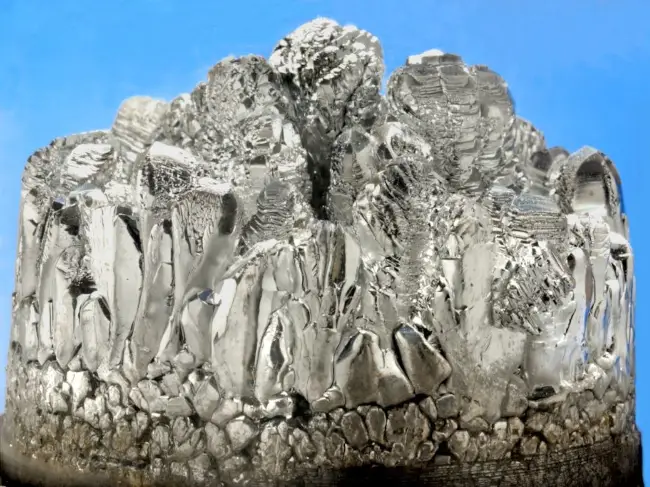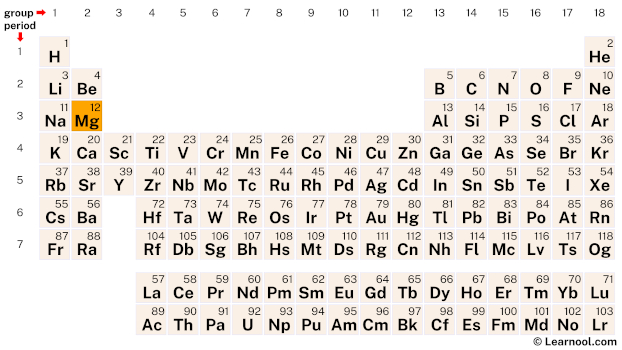
Magnesium (Mg) is a chemical element with the atomic number 12. It is classified as an alkaline earth metal and is located in group 2 and period 3 of the periodic table. The element was first isolated by Sir Humphry Davy in 1808 through the electrolysis of magnesium oxide. Its name is derived from Magnesia, a district in Thessaly, Greece where large deposits of magnesium minerals were first found.
Magnesium is one of the most abundant elements in the Earth’s crust and is primarily found in minerals such as magnesite, dolomite, and carnallite. It is also present in seawater and in many living organisms, including plants and animals. In its pure form, magnesium is a shiny, silvery-white metal that is relatively soft and malleable. It is highly reactive and can ignite in air, making it a popular component in fireworks and flares.
Due to its lightweight and high strength-to-weight ratio, magnesium is also commonly used in the aerospace industry to make aircraft components and in the manufacturing of lightweight alloys. Additionally, magnesium plays an important role in biological processes and is essential for many bodily functions, including muscle and nerve function, energy production, and DNA synthesis.[1] Despite its abundance and importance, magnesium is often overlooked and undervalued compared to other elements in the periodic table.
On periodic table
| group | ⇨ | 1 | 2 | 3 | 4 | 5 | 6 | 7 | 8 | 9 | 10 | 11 | 12 | 13 | 14 | 15 | 16 | 17 | 18 |
| period | ⇩ | ||||||||||||||||||
| 1 | 1 H  Hydrogen |
2 He  Helium |
|||||||||||||||||
| 2 | 3 Li  Lithium |
4 Be  Beryllium |
5 B  Boron |
6 C  Carbon |
7 N  Nitrogen |
8 O  Oxygen |
9 F  Fluorine |
10 Ne  Neon |
|||||||||||
| 3 | 11 Na  Sodium |
12 Mg Magnesium |
13 Al  Aluminium |
14 Si Silicon |
15 P  Phosphorus |
16 S  Sulfur |
17 Cl  Chlorine |
18 Ar  Argon |
|||||||||||
| 4 | 19 K  Potassium |
20 Ca  Calcium |
21 Sc  Scandium |
22 Ti  Titanium |
23 V  Vanadium |
24 Cr  Chromium |
25 Mn  Manganese |
26 Fe  Iron |
27 Co  Cobalt |
28 Ni  Nickel |
29 Cu  Copper |
30 Zn  Zinc |
31 Ga  Gallium |
32 Ge  Germanium |
33 As  Arsenic |
34 Se  Selenium |
35 Br  Bromine |
36 Kr  Krypton |
|
| 5 | 37 Rb  Rubidium |
38 Sr  Strontium |
39 Y  Yttrium |
40 Zr  Zirconium |
41 Nb  Niobium |
42 Mo  Molybdenum |
43 Tc  Technetium |
44 Ru  Ruthenium |
45 Rh  Rhodium |
46 Pd  Palladium |
47 Ag  Silver |
48 Cd  Cadmium |
49 In  Indium |
50 Sn  Tin |
51 Sb  Antimony |
52 Te  Tellurium |
53 I  Iodine |
54 Xe  Xenon |
|
| 6 | 55 Cs  Caesium |
56 Ba  Barium |
72 Hf  Hafnium |
73 Ta  Tantalum |
74 W  Tungsten |
75 Re  Rhenium |
76 Os  Osmium |
77 Ir  Iridium |
78 Pt  Platinum |
79 Au  Gold |
80 Hg  Mercury |
81 Tl  Thallium |
82 Pb  Lead |
83 Bi  Bismuth |
84 Po  Polonium |
85 At  Astatine |
86 Rn  Radon |
||
| 7 | 87 Fr  Francium |
88 Ra  Radium |
104 Rf  Rutherfordium |
105 Db  Dubnium |
106 Sg  Seaborgium |
107 Bh  Bohrium |
108 Hs  Hassium |
109 Mt  Meitnerium |
110 Ds  Darmstadtium |
111 Rg  Roentgenium |
112 Cn  Copernicium |
113 Nh  Nihonium |
114 Fl  Flerovium |
115 Mc  Moscovium |
116 Lv  Livermorium |
117 Ts  Tennessine |
118 Og  Oganesson |
||
| 57 La  Lanthanum |
58 Ce  Cerium |
59 Pr  Praseodymium |
60 Nd  Neodymium |
61 Pm  Promethium |
62 Sm  Samarium |
63 Eu  Europium |
64 Gd  Gadolinium |
65 Tb  Terbium |
66 Dy  Dysprosium |
67 Ho  Holmium |
68 Er  Erbium |
69 Tm  Thulium |
70 Yb  Ytterbium |
71 Lu  Lutetium |
|||||
| 89 Ac  Actinium |
90 Th  Thorium |
91 Pa  Protactinium |
92 U  Uranium |
93 Np  Neptunium |
94 Pu  Plutonium |
95 Am  Americium |
96 Cm  Curium |
97 Bk  Berkelium |
98 Cf  Californium |
99 Es  Einsteinium |
100 Fm  Fermium |
101 Md  Mendelevium |
102 No  Nobelium |
103 Lr  Lawrencium |
|||||
| – s block |
Magnesium is an s-block element, situated in the second column of the periodic table, next to sodium (Na). It has the atomic number 12 and is denoted by the symbol Mg.
Element information
 |
|
 |
|
| Origin of name | named after Magnesia, a district of Eastern Thessaly in Greece |
| Symbol | Mg |
| Atomic number (Z) | 12 |
| Atomic mass | 24.305 u |
| Block | s-block |
| Group | 2 |
| Period | 3 |
| Classification | Alkaline earth metal |
| Atomic radius | 160 pm |
| Covalent radius | 141±7 pm |
| Van der Waals radius | 173 pm |
| Melting point | 650 ℃, 1202 ℉, 923 K |
| Boiling point | 1091 ℃, 1994 ℉, 1363 K |
| Electron configuration | [He] 3s2 |
| Electrons per shell | 2, 8, 2 |
| Learn how to draw: Magnesium Bohr model | |
| Crystal structure | Hexagonal close-packed (hcp) |
| Phase at r.t | Solid |
| Density near r.t | 1.738 g/cm3 |
| Main isotopes | Magnesium-24, Magnesium-25, Magnesium-26 |
| Natural occurrence | Primordial |
| Oxidation state | +2 |
| Electronegativity (Pauling scale) | 1.31 |
| Protons Neutrons Electrons |
12 12 12 |
| Learn how to find: Magnesium protons neutrons electrons | |
| Valence electrons | 2 |
| Learn how to find: Magnesium valence electrons | |
| CAS number | 7439-95-4 |
| Discovered by | Joseph Black in 1755 |
History

Magnesium was first isolated in 1808 by Sir Humphry Davy, an English chemist, by the electrolysis of a mixture of magnesium oxide (MgO) and mercuric oxide (HgO). However, magnesium was recognized as an important element long before its isolation. The ancient Greeks and Romans used magnesium-rich mineral waters to treat a variety of ailments, and the word “magnesia” was used to describe both the mineral and the region of Thessaly where it was found.
In 1755, Scottish chemist Joseph Black recognized magnesia alba (now known as magnesium carbonate) as a distinct substance, and in 1803, French chemist Antoine Bussy produced a small sample of metallic magnesium through the reduction of magnesium chloride with potassium. Davy’s isolation of magnesium from magnesia alba and other minerals marked the first successful large-scale production of the metal. Magnesium’s name comes from Magnesia, a district of Thessaly in Greece where large deposits of magnesium-rich minerals were discovered. The metal has since become an important industrial material due to its lightweight, high strength, and excellent corrosion resistance.
Occurrence
Magnesium is found in large deposits all over the world. The most common minerals containing magnesium are dolomite and magnesite, which are mined in many countries, including the United States, China, Russia, and Brazil. Magnesium is also present in seawater, where it is the third most abundant element after sodium and chlorine. It is estimated that seawater contains around 0.13% magnesium by weight, which makes it a potential source of magnesium extraction.[2]
Additionally, magnesium is found in brines, which are concentrated solutions of salt and minerals found underground. In terms of commercial production, magnesium is primarily produced in China, which accounts for around 85% of global production.[5] Other major producers include Russia, Ukraine, and Kazakhstan.
Production
Magnesium is produced primarily by two methods: thermal reduction and electrolysis.[2] Thermal reduction involves the reduction of magnesium oxide (MgO) with a reducing agent such as ferrosilicon, while electrolysis involves the electrolytic reduction of magnesium chloride (MgCl2) dissolved in molten salt. Thermal reduction is the more common method of production and accounts for around 90% of global magnesium production.[3]
The process begins with the extraction of magnesium-rich minerals such as magnesite or dolomite, which are then heated in a furnace to produce magnesium oxide. The magnesium oxide is then mixed with a reducing agent such as ferrosilicon and heated to high temperatures in a furnace. The reducing agent reacts with the magnesium oxide to produce magnesium vapor, which is condensed and collected in a chamber.
Electrolytic production of magnesium is less common and is typically used for high-purity applications. In this process, magnesium chloride is dissolved in a molten mixture of sodium chloride and calcium chloride. An electric current is passed through the molten salt, causing the magnesium ions to be reduced to metallic magnesium at the cathode. Both methods of production require significant amounts of energy, with thermal reduction using more energy than electrolysis. However, improvements in technology and energy efficiency have made magnesium production more economical in recent years.
Properties
Magnesium is a silvery-white metal with a density of 1.738 grams per cubic centimeter. It has a melting point of 650 ℃ and a boiling point of 1091 ℃.
Magnesium is highly reactive and easily ignites in air, which makes it useful in pyrotechnics and flares. It is also highly flammable and must be handled with care.
Magnesium is a relatively soft metal, with a Mohs hardness of 2.5, and is highly ductile and malleable. It is a good conductor of electricity and heat, and has excellent machining properties.
Magnesium is also highly corrosion-resistant, which makes it useful in a variety of applications, such as in the automotive industry, where it is used for engine blocks and other components.
Magnesium is the eighth most abundant element in the Earth’s crust and is found in many minerals, such as dolomite and magnesite.[4] It is also present in seawater and brines, and can be extracted from these sources.
Applications
One of the primary uses of magnesium is in the production of aluminum alloys, where it is added to improve the strength and corrosion resistance of the alloy.
Magnesium is also used as a reducing agent in the production of other metals, such as titanium, zirconium, and uranium.
Another important use of magnesium is in the production of magnesium oxide, which is used as a refractory material in furnace linings and in the production of ceramics. Magnesium oxide is also used as an antacid and laxative, and is an important ingredient in many pharmaceutical products.
Magnesium is also used in the aerospace and automotive industries, where its low density and high strength make it an attractive material for lightweight structural components.
It is used in the production of engine blocks, wheels, and other components in the automotive industry, and in the production of aircraft parts, such as wing ribs and fuselage frames.

In addition to its industrial uses, magnesium is also an important nutrient for plants and animals. It is a key component of chlorophyll, which is the pigment that gives plants their green color and is essential for photosynthesis.
Magnesium is also important for human health, where it is required for the proper functioning of muscles, nerves, and enzymes.
Interesting facts
Magnesium is a silvery-white metal that is relatively soft and ductile, and has a hexagonal crystal structure.

Magnesium is highly flammable and burns with a bright white light, making it a popular material for fireworks and flares.
Magnesium is named after the Greek city of Magnesia, where it was first discovered.
Magnesium is a very reactive element and is not found in its pure form in nature. Instead, it is typically found in combination with other elements, such as calcium, chlorine, and oxygen.
Magnesium is essential for human health, where it plays a critical role in many biochemical reactions in the body, including the metabolism of carbohydrates and the synthesis of proteins and DNA.
Magnesium is used in the production of batteries, where it is combined with other metals, such as zinc and manganese, to create anodes.
Magnesium is also used in the production of flashbulbs, where it is ignited by an electrical current to produce a bright white light.
Magnesium is the lightest structural metal, with a density that is about two-thirds that of aluminum.
Magnesium is also used in the production of alloys that are used in golf clubs, luggage frames, and other consumer products due to their lightweight and durable properties.
Related
More elements
References
1. Pros and cons of taking a magnesium supplement – Mayo Clinic
2. About Magnesium – International Magnesium Association
4. Magnesium Statistics and Information | U.S. Geological Survey
5. Why it matters that magnesium is in short supply | The Economist
External links
- https://pubchem.ncbi.nlm.nih.gov/element/Magnesium
- https://www.rsc.org/periodic-table/element/12/magnesium
- https://www.britannica.com/science/magnesium
- https://en.wikipedia.org/wiki/Magnesium
- https://chemistrytalk.org/magnesium-element/
- https://www.ducksters.com/science/chemistry/magnesium.php
- https://www.chemicool.com/elements/magnesium.html
Deep
Learnool.com was founded by Deep Rana, who is a mechanical engineer by profession and a blogger by passion. He has a good conceptual knowledge on different educational topics and he provides the same on this website. He loves to learn something new everyday and believes that the best utilization of free time is developing a new skill.
